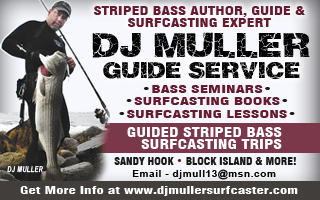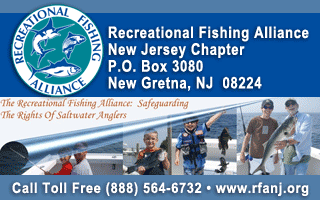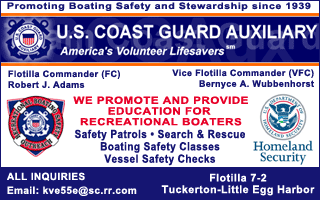
Last year's seismic study of an area as close as 25 miles from Barnegat Bay that blasted the ocean floor with seismic air cannons at serious sound levels is back again. Last year's study was cut short due to mechanical equipment failure. The Asbury Park Press reports that the study area will be 25 to 85 nautical miles southeast of Barnegat Inlet. Paul Haertel, President of the Jersey Coast Anglers Association reported to FishinJersey editors that the area will include important fishing grounds including The Fingers, Barnegat Ridge, The Lillian Wreck, and the 28 Mile Wreck. Cindy Zipf, executive director of Clean Ocean Action told the Asbury Park Press, “It’s pretty much the same project from last year. They say it won’t have any environmental impacts, but we think there will be”. Zipf went on to say that the study may be detrimental to marine life such as whales and scallops and believes the publicly published results could lead to oil drilling if deposits are indeed discovered through the study.
Last year, after all federal statutory and regulatory obligations were completed for the survey, the study began amid much opposition from Clean Ocean Action and other environmental groups. However, because of mechanical issues with the vessel, the survey was unable to be completed during the allotted time frame.
This second seismic study, just 25 nautical miles from the Barnegat inlet, once again will include researchers from Columbia University's Lamont-Doherty Earth Observatory, Rutgers University as well as additional researchers from the National Science Foundation. The group has applied for and received an "Incidental Take Authorization" (ITA) from the National Oceanic and Atmospheric Administration (NOAA). According to the NOAA web site: "Incidental take is an unintentional, but not unexpected, “take”. Taking is prohibited, with certain exceptions, under the Marine Mammal Protection Act (MMPA). However, the MMPA allows, upon request, the incidental take of small numbers of marine mammals by U.S. citizens who engage in a specified activity--other than commercial fishing--within a specified geographic region". By applying for and receiving this authorization, it may be inferred that the scientists and study personnel are admitting there is, in fact, a possible danger to New Jersey's marine mammals from the sonic blasts used in the seismic study.
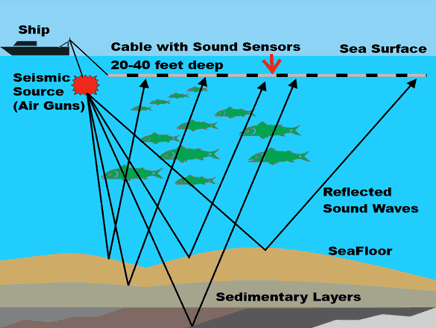 |
| Ships drag air cannons which fire compressed air at up to 250 dB to the ocean floor. The reflected sound energy is read by sensors dragged on a cable on the ocean surface. the data is read by software and translated into images. (FishinJersey Graphic) |
What is troubling for environmentalists, New Jersey's recreational fisherman, and commercial fishing fleet operators is that in the past, seismic studies have taken place off the Alaskan coast and their effects on the commercial cod, haddock and rockfish industries are clearly documented in their fact sheet entitled "Impacts of Seismic Surveys on Marine Mammals and Fish" by the Alaska Marine Conservation Council.
According to the Alaskan study, "Seismic surveys not only threaten commercial and subsistence fishing by harming fish resources, but also by interfering with fishing operations and dramatically affecting catch rates. Seismic ships tow streamers that can be miles long. These can get tangled up with crab pots, set nets and trawl nets causing damage and decreasing crucial fishing time. As a result, seismic survey operations can end up competing with fishing for time and space on the water."
The Alaskan Marine Council study goes on to state that: "Even if these kinds of conflicts can be avoided, several studies have shown that seismic operations have greatly reduced catches of fish around areas where air guns were being fired. These studies have demonstrated reduced catches over 20 miles away from the source with catch reductions continuing five days after the testing was complete (See Table below). Researchers believe these catch reductions are a result of altered fish behavior due to seismic operations which cause them to be less likely to take hooks and/or to move down and away from the seismic firing."
Reductions in Alaskan Fish Catch Rates as a Result of Seismic Survey Activity
Species |
Gear type |
Noise level of |
Catch reduction |
Source |
Atlantic cod |
Trawl |
250 decibels (dB) |
46-69% lasting at least |
Engas et al. 1993 |
Atlantic cod |
Longline |
250 decibels (dB) |
17-45% lasting at least |
Engas et al. 1993 |
Atlantic cod |
Longline |
Undetermined, 9.32 |
55-79 % lasting at least |
Lokkeborg and Soldal, 1993 |
Haddock |
Trawl |
250 decibels (dB) |
70-72% lasting at least |
Engas et al. 1993 |
Haddock |
Longline |
250 decibels (dB) |
49-73% lasting at least |
Engas et al. 1993 |
Rockfish |
Longline |
223 decibels (dB) |
52%- effect period not |
Skalski et al., 1992 |
(Source of Chart: Alaskan Marine Council)
According to Clean Ocean Action, "A 2003 study in the Journal of the Acoustical Society of America confirmed that seismic air guns used in underwater oil exploration damage the auditory organs of fish. More studies are finding impacts of seismic testing and other acoustic technology range from harassment to death. The Environmental Assessment prepared for this study scarcely considers the serious threats to fish and shellfish. It devotes less than 250 words to marine invertebrates (crustaceans and cephalopods), fish and their fisheries, and it does not mention impacts to bivalves such as surf clams and scallops." It seems that the institutions proposing this study really haven't much concern about the effects it may have on New Jersey crabs, squid, shrimp, clams and scallops either.
However, that is not the only marine population that can be effected. Scientists believe that pods of whales (that include calves) are at serious risk from seismic activities due to their need to utilize critical habitats for feeding and resting. If seismic surveys displace whales from these areas so critical to their survival, population-level consequences may result. Dr. Lance Barret-Lennard, Senior Marine Mammal Scientist at the Vancouver Marine Science Center, has asserted that seismic exploration is one of the two greatest threats to whales and dolphins.
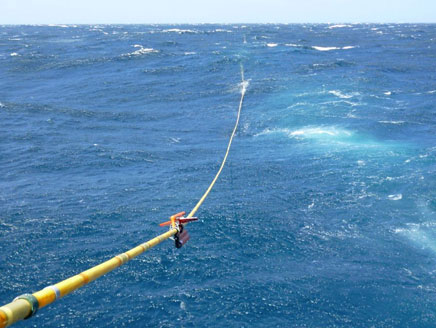 |
| Seismic ships tow LONG cables which may interfere with commercial longliners and trawlers. Studies in Alaska confirmed reductions in commercial catches. The study also reported changes in fish patterns and whale migratory pattern changes. |
Disregarding these studies and comments from environmentalists, Lincoln S. Hollister, an emeritus professor of geosciences and senior geologist at Princeton University authored an article published online by the Asbury Park Press. In the article, Hollister states:
"Environmental groups' opposition to science-focused marine seismic surveys erodes the ability of academics to do research. Students' and young scientists' careers already have been interrupted, and future students are deterred from entering oceanography because of the wasted time and money to fend off destructive attacks orchestrated by the deluded environmental groups."
Mr. Hollister does report that the seismic equipment being used for this study is only about 1/10 the size of oil and gas seismic equipment, lessening the danger to marine life. The levels will not reach those used when the results of the Alaskan Fishing Council Study were being compiled.
Regardless of the financial impact in disrupted fishing, there are also unanswered questions about seismic impact upon marine invertebrates and shellfish. Studies show that blasts from these seismic air guns can injure or disturb vital behaviors in fish, dolphins, whales and sea turtles. The marine life impacts from these blasts can include temporary or permanent hearing loss and temporary abandonment of habitat, as well as disruption of mating and feeding.
Professor Hollister's additional remarks published on the Press web site are significantly troubling. His opinion? Here it is:
"The agencies supporting basic research do not have deep enough pockets to fend off the persistent, irrational, misinformed attacks from these environmental groups and politicians. Science is built on trust and fact checking. We cannot understand people that willfully distort or make up facts, and who ignore evidence that proves that the basis of their objections is just plain wrong."
Mr. Hollister, we researched the facts and have included passages and tables from the Alaskan study as well as comments from leading scientists and environmentalists documenting some troubling information about seismic testing. It is important to note, that there is not one single study cited in your article. Show us YOUR data. Show us YOUR studies. Maybe then we can better understand your position.
FishinJersey.com feels that any seismic testing that could disrupt commercial and recreational fishing, possibly pose any danger to young marine mammals and take place at such a critical period during the fishing season are unwarranted, especially during this time of the year.
According to the National Oceanic and Atmospheric Administration Fisheries web site, the New Jersey Recreational Fishing Industry annually accounts for approximately $1.7 billion in sales and nearly 10,000 jobs. Add to that New Jersey's commercial fishery, which has the highest landings revenue in the Mid-Atlantic Region with annual revenues over 200 million dollars, and we are talking about a New Jersey fishing industry that accounts for nearly 2 BILLION dollars in revenue per year! A majority of that revenue is being generated in the summer season when the study will take place. If you feel strongly about the impacts of the seismic study on New Jersey's recreational and commercial fishing industries, you may email Rutgers University President Robert Barchi at:
http://president.rutgers.edu/contact/send-message-president-barchi
Please remain civil and cite factual information. You may take that from our article. Remember, Mr. Barchi did NOT write the comments in our article and Mr. Hollister (who did write them!) does not even work for Rutgers University... he works for Princeton University. Thank you for your comments and concern. As Jack Webb used to say on Dragnet..."Just the facts, please".





